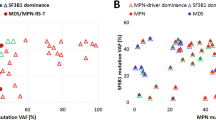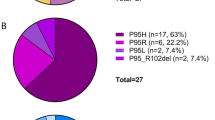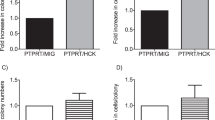Abstract
Chronic myeloproliferative diseases (CMPDs) are characterized by the abnormal proliferation and survival of one or more myeloid cell types. The archetype of this class of hematological diseases is chronic myeloid leukemia (CML), characterized by the presence of the Philadelphia (Ph) chromosome, the result of t(9;22)(q34;q11), and the associated BCR-ABL1 oncogene. Some of the Ph-negative myeloproliferative diseases are characterized by other chromosomal translocations involving a variety of tyrosine kinase genes, including ABL1, ABL2, PDGFRA, PDGFRB, FGFR1, and JAK2. The majority of Ph-negative CMPDs, however, such as chronic eosinophilic leukemia, polycythemia vera, essential thrombocythemia, and idiopathic myelofibrosis are not characterized by the presence of recurrent chromosomal abnormalities. Recent studies have identified the FIP1L1-PDGFRA fusion gene, generated due to a small cryptic deletion on chromosome 4q12, and the activating V617F mutation in JAK2 in a significant fraction of Ph-negative CMPDs. These results show that abnormalities in tyrosine kinase genes are central to the molecular pathogenesis of CMPDs. Genome-wide screenings to identify novel tyrosine kinase abnormalities in CMPDs may contribute to further improvement of the diagnosis and the treatment of these diseases.
This is a preview of subscription content, access via your institution
Access options
Subscribe to this journal
Receive 12 print issues and online access
$259.00 per year
only $21.58 per issue
Buy this article
- Purchase on Springer Link
- Instant access to full article PDF
Prices may be subject to local taxes which are calculated during checkout

Similar content being viewed by others
References
Ren R . Mechanisms of BCR-ABL in the pathogenesis of chronic myelogenous leukaemia. Nat Rev Cancer 2005; 5: 172–183.
Capdeville R, Buchdunger E, Zimmermann J, Matter A . Glivec (STI571, imatinib), a rationally developed, targeted anticancer drug. Nat Rev Drug Discov 2002; 1: 493–502.
Cross NC, Reiter A . Tyrosine kinase fusion genes in chronic myeloproliferative diseases. Leukemia 2002; 16: 1207–1212.
Bousquet M, Quelen C, De Mas V, Duchayne E, Roquefeuil B, Delsol G et al. The t(8;9)(p22;p24) translocation in atypical chronic myeloid leukaemia yields a new PCM1-JAK2 fusion gene. Oncogene 2005; 24: 7248–7252.
Murati A, Gelsi-Boyer V, Adelaide J, Perot C, Talmant P, Giraudier S et al. PCM1-JAK2 fusion in myeloproliferative disorders and acute erythroid leukemia with t(8;9) translocation. Leukemia 2005; 19: 1692–1696.
Reiter A, Walz C, Watmore A, Schoch C, Blau I, Schlegelberger B et al. The t(8;9)(p22;p24) is a recurrent abnormality in chronic and acute leukemia that fuses PCM1 to JAK2. Cancer Res 2005; 65: 2662–2667.
Longley BJ, Tyrrell L, Lu SZ, Ma YS, Langley K, Ding TG et al. Somatic c-KIT activating mutation in urticaria pigmentosa and aggressive mastocytosis: establishment of clonality in a human mast cell neoplasm. Nat Genet 1996; 12: 312–314.
Cools J, DeAngelo DJ, Gotlib J, Stover EH, Legare RD, Cortes J et al. A tyrosine kinase created by fusion of the PDGFRA and FIP1L1 genes as a therapeutic target of imatinib in idiopathic hypereosinophilic syndrome. N Engl J Med 2003; 348: 1201–1214.
Baxter EJ, Scott LM, Campbell PJ, East C, Fourouclas N, Swanton S et al. Acquired mutation of the tyrosine kinase JAK2 in human myeloproliferative disorders. Lancet 2005; 365: 1054–1061.
James C, Ugo V, Le Couedic JP, Staerk J, Delhommeau F, Lacout C et al. A unique clonal JAK2 mutation leading to constitutive signalling causes polycythaemia vera. Nature 2005; 434: 1144–1148.
Kralovics R, Passamonti F, Buser AS, Teo SS, Tiedt R, Passweg JR et al. A gain-of-function mutation of JAK2 in myeloproliferative disorders. N Engl J Med 2005; 352: 1779–1790.
Levine RL, Wadleigh M, Cools J, Ebert BL, Wernig G, Huntly BJ et al. Activating mutation in the tyrosine kinase JAK2 in polycythemia vera, essential thrombocythemia, and myeloid metaplasia with myelofibrosis. Cancer Cell 2005; 7: 387–397.
Zhao R, Xing S, Li Z, Fu X, Li Q, Krantz SB et al. Identification of an acquired JAK2 mutation in polycythemia vera. J Biol Chem 2005; 280: 22788–22792.
Baxter EJ, Hochhaus A, Bolufer P, Reiter A, Fernandez JM, Senent L et al. The t(4;22)(q12;q11) in atypical chronic myeloid leukaemia fuses BCR to PDGFRA. Hum Mol Genet 2002; 11: 1391–1397.
La Starza R, Specchia G, Cuneo A, Beacci D, Nozzoli C, Luciano L et al. The hypereosinophilic syndrome: fluorescence in situ hybridization detects the del(4)(q12)-FIP1L1/PDGFRA but not genomic rearrangements of other tyrosine kinases. Haematologica 2005; 90: 596–601.
Roche-Lestienne C, Lepers S, Soenen-Cornu V, Kahn JE, Lai JL, Hachulla E et al. Molecular characterization of the idiopathic hypereosinophilic syndrome (HES) in 35 French patients with normal conventional cytogenetics. Leukemia 2005; 19: 792–798.
Vandenberghe P, Wlodarska I, Michaux L, Zachee P, Boogaerts M, Vanstraelen D et al. Clinical and molecular features of FIP1L1-PDFGRA (+) chronic eosinophilic leukemias. Leukemia 2004; 18: 734–742.
Klion AD, Noel P, Akin C, Law MA, Gilliland DG, Cools J et al. Elevated serum tryptase levels identify a subset of patients with a myeloproliferative variant of idiopathic hypereosinophilic syndrome associated with tissue fibrosis, poor prognosis, and imatinib responsiveness. Blood 2003; 101: 4660–4666.
Cools J, Quentmeier H, Huntly BJ, Marynen P, Griffin JD, Drexler HG et al. The EOL-1 cell line as an in vitro model for the study of FIP1L1-PDGFRA-positive chronic eosinophilic leukemia. Blood 2004; 103: 2802–2805.
Klion AD, Robyn J, Akin C, Noel P, Brown M, Law M et al. Molecular remission and reversal of myelofibrosis in response to imatinib mesylate treatment in patients with the myeloproliferative variant of hypereosinophilic syndrome. Blood 2004; 103: 473–478.
von Bubnoff N, Sandherr M, Schlimok G, Andreesen R, Peschel C, Duyster J . Myeloid blast crisis evolving during imatinib treatment of an FIP1L1-PDGFR alpha-positive chronic myeloproliferative disease with prominent eosinophilia. Leukemia 2005; 19: 286–287.
Cools J, Stover EH, Boulton CL, Gotlib J, Legare RD, Amaral SM et al. PKC412 overcomes resistance to imatinib in a murine model of FIP1L1-PDGFRalpha-induced myeloproliferative disease. Cancer Cell 2003; 3: 459–469.
de la Chapelle A, Traskelin AL, Juvonen E . Truncated erythropoietin receptor causes dominantly inherited benign human erythrocytosis. Proc Natl Acad Sci USA 1993; 90: 4495–4499.
Watowich SS, Xie X, Klingmuller U, Kere J, Lindlof M, Berglund S et al. Erythropoietin receptor mutations associated with familial erythrocytosis cause hypersensitivity to erythropoietin in the heterozygous state. Blood 1999; 94: 2530–2532.
Saharinen P, Vihinen M, Silvennoinen O . Autoinhibition of Jak2 tyrosine kinase is dependent on specific regions in its pseudokinase domain. Mol Biol Cell 2003; 14: 1448–1459.
Jones AV, Kreil S, Zoi K, Waghorn K, Curtis C, Zhang L et al. Widespread occurrence of the JAK2 V617F mutation in chronic myeloproliferative disorders. Blood 2005; 106: 2162–2168.
Steensma DP, Dewald GW, Lasho TL, Powell HL, McClure RF, Levine RL et al. The JAK2 V617F activating tyrosine kinase mutation is an infrequent event in both ‘atypical’ myeloproliferative disorders and the myelodysplastic syndrome. Blood 2005; 106: 1207–1209.
Levine RL, Loriaux M, Huntly BJ, Loh M, Beran M, Stoffregen E et al. The JAK2V617F activating mutation occurs in chronic myelomonocytic leukemia and acute myeloid leukemia, but not in acute lymphoblastic leukemia or chronic lymphocytic leukemia. Blood 2005; 106: 3377–3379.
Valent P, Akin C, Sperr WR, Mayerhofer M, Fodinger M, Fritsche-Polanz R et al. Mastocytosis: pathology, genetics, and current options for therapy. Leuk Lymphoma 2005; 46: 35–48.
Gleixner KV, Mayerhofer M, Aichberger KJ, Derdak S, Sonneck K, Bohm A et al. PKC412 inhibits in vitro growth of neoplastic human mast cells expressing the D816V-mutated variant of KIT: comparison with AMN107, imatinib, and cladribine (2CdA), and evaluation of cooperative drug effects. Blood 2005 [Sep 27, E-pub ahead of print].
Gotlib J, Berube C, Growney JD, Chen CC, George TI, Williams C et al. Activity of the tyrosine kinase inhibitor PKC412 in a patient with mast cell leukemia with the D816V KIT mutation. Blood 2005; 106: 2865–2870.
von Bubnoff N, Gorantla SH, Kancha RK, Lordick F, Peschel C, Duyster J . The systemic mastocytosis-specific activating cKit mutation D816V can be inhibited by the tyrosine kinase inhibitor AMN107. Leukemia 2005; 19: 1670–1671.
Quentmeier H, Cools J, MacLeod RA, Marynen P, Uphoff CC, Drexler HG . e6-a2 BCR-ABL1 fusion in T-cell acute lymphoblastic leukemia. Leukemia 2005; 19: 295–296.
Beillard E, Pallisgaard N, van der Velden V, Bi W, Dee R, van der Schoot E et al. Evaluation of candidate control genes for diagnosis and residual disease detection in leukemic patients using ‘real-time’ quantitative reverse-transcriptase polymerase chain reaction (RQ-PCR) – a Europe against cancer program. Leukemia 2003; 17: 2474–2486.
Jelinek J, Oki Y, Gharibyan V, Bueso-Ramos C, Prchal JT, Verstovsek S et al. JAK2 mutation 1849G>T is rare in acute leukemias but can be found in CMML, Philadelphia-chromosome negative CML and megakaryocytic leukemia. Blood 2005; 106: 3370–3373.
Barber KE, Martineau M, Harewood L, Stewart M, Cameron E, Strefford JC et al. Amplification of the ABL gene in T-cell acute lymphoblastic leukemia. Leukemia 2004; 18: 1153–1156.
Graux C, Cools J, Melotte C, Quentmeier H, Ferrando A, Levine R et al. Fusion of NUP214 to ABL1 on amplified episomes in T-cell acute lymphoblastic leukemia. Nat Genet 2004; 36: 1084–1089.
De Keersmaecker K, Graux C, Odero MD, Mentens N, Somers R, Maertens J et al. Fusion of EML1 to ABL1 in T-cell acute lymphoblastic leukemia with cryptic t(9;14)(q34;q32). Blood 2005; 105: 4849–4852.
Speleman F, Cauwelier B, Dastugue N, Cools J, Verhasselt B, Poppe B et al. A new recurrent inversion, inv(7)(p15q34), leads to transcriptional activation of HOXA10 and HOXA11 in a subset of T-cell acute lymphoblastic leukemias. Leukemia 2005; 19: 358–366.
Stephens P, Hunter C, Bignell G, Edkins S, Davies H, Teague J et al. Lung cancer: intragenic ERBB2 kinase mutations in tumours. Nature 2004; 431: 525–526.
Cools J, Mentens N, Odero MD, Peeters P, Wlodarska I, Delforge M et al. Evidence for position effects as a variant ETV6-mediated leukemogenic mechanism in myeloid leukemias with a t(4;12)(q11-q12;p13) or t(5;12)(q31;p13). Blood 2002; 99: 1776–1784.
Druker BJ, Talpaz M, Resta DJ, Peng B, Buchdunger E, Ford JM et al. Efficacy and safety of a specific inhibitor of the BCR-ABL tyrosine kinase in chronic myeloid leukemia. N Engl J Med 2001; 344: 1031–1037.
Weisberg E, Manley PW, Breitenstein W, Bruggen J, Cowan-Jacob SW, Ray A et al. Characterization of AMN107, a selective inhibitor of native and mutant Bcr-Abl. Cancer Cell 2005; 7: 129–141.
Shah NP, Tran C, Lee FY, Chen P, Norris D, Sawyers CL . Overriding imatinib resistance with a novel ABL kinase inhibitor. Science 2004; 305: 399–401.
Van Limbergen H, Beverloo HB, van Drunen E, Janssens A, Hahlen K, Poppe B et al. Molecular cytogenetic and clinical findings in ETV6/ABL1-positive leukemia. Genes Chromosomes Cancer 2001; 30: 274–282.
Apperley JF, Gardembas M, Melo JV, Russell-Jones R, Bain BJ, Baxter EJ et al. Response to imatinib mesylate in patients with chronic myeloproliferative diseases with rearrangements of the platelet-derived growth factor receptor beta. N Engl J Med 2002; 347: 481–487.
Stover EH, Chen J, Lee BH, Cools J, McDowell E, Adelsperger J et al. The small molecule tyrosine kinase inhibitor AMN107 inhibits TEL-PDGFR{beta} and FIP1L1-PDGFR{alpha} in vitro and in vivo. Blood 2005; 106: 3206–3213.
Golub TR, Barker GF, Lovett M, Gilliland DG . Fusion of PDGF receptor beta to a novel ets-like gene, tel, in chronic myelomonocytic leukemia with t(5;12) chromosomal translocation. Cell 1994; 77: 307–316.
Ross TS, Bernard OA, Berger R, Gilliland DG . Fusion of Huntingtin interacting protein 1 to platelet-derived growth factor beta receptor (PDGFbetaR) in chronic myelomonocytic leukemia with t(5;7)(q33;q11.2). Blood 1998; 91: 4419–4426.
Schwaller J, Anastasiadou E, Cain D, Kutok J, Wojiski S, Williams IR et al. H4(D10S170), a gene frequently rearranged in papillary thyroid carcinoma, is fused to the platelet-derived growth factor receptor beta gene in atypical chronic myeloid leukemia with t(5;10)(q33;q22). Blood 2001; 97: 3910–3918.
Kulkarni S, Heath C, Parker S, Chase A, Iqbal S, Pocock CF et al. Fusion of H4/D10S170 to the platelet-derived growth factor receptor beta in BCR-ABL-negative myeloproliferative disorders with a t(5;10)(q33;q21). Cancer Res 2000; 60: 3592–3598.
Levine RL, Wadleigh M, Sternberg DW, Wlodarska I, Galinsky I, Stone RM et al. KIAA1509 is a novel PDGFRB fusion partner in imatinib-responsive myeloproliferative disease associated with a t(5;14)(q33;q32). Leukemia 2005; 19: 27–30.
Abe A, Emi N, Tanimoto M, Terasaki H, Marunouchi T, Saito H . Fusion of the platelet-derived growth factor receptor beta to a novel gene CEV14 in acute myelogenous leukemia after clonal evolution. Blood 1997; 90: 4271–4277.
Vizmanos JL, Novo FJ, Roman JP, Baxter EJ, Lahortiga I, Larrayoz MJ et al. NIN, a gene encoding a CEP110-like centrosomal protein, is fused to PDGFRB in a patient with a t(5;14)(q33;q24) and an imatinib-responsive myeloproliferative disorder. Cancer Res 2004; 64: 2673–2676.
Grand FH, Burgstaller S, Kuhr T, Baxter EJ, Webersinke G, Thaler J et al. p53-Binding protein 1 is fused to the platelet-derived growth factor receptor beta in a patient with a t(5;15)(q33;q22) and an imatinib-responsive eosinophilic myeloproliferative disorder. Cancer Res 2004; 64: 7216–7219.
Morerio C, Acquila M, Rosanda C, Rapella A, Dufour C, Locatelli F et al. HCMOGT-1 is a novel fusion partner to PDGFRB in juvenile myelomonocytic leukemia with t(5;17)(q33;p11.2). Cancer Res 2004; 64: 2649–2651.
Magnusson MK, Meade KE, Brown KE, Arthur DC, Krueger LA, Barrett AJ et al. Rabaptin-5 is a novel fusion partner to platelet-derived growth factor beta receptor in chronic myelomonocytic leukemia. Blood 2001; 98: 2518–2525.
Chen J, DeAngelo DJ, Kutok JL, Williams IR, Lee BH, Wadleigh M et al. PKC412 inhibits the zinc finger 198-fibroblast growth factor receptor 1 fusion tyrosine kinase and is active in treatment of stem cell myeloproliferative disorder. Proc Natl Acad Sci USA 2004; 101: 14479–14484.
Reiter A, Sohal J, Kulkarni S, Chase A, Macdonald DH, Aguiar RC et al. Consistent fusion of ZNF198 to the fibroblast growth factor receptor-1 in the t(8;13)(p11;q12) myeloproliferative syndrome. Blood 1998; 92: 1735–1742.
Xiao S, Nalabolu SR, Aster JC, Ma J, Abruzzo L, Jaffe ES et al. FGFR1 is fused with a novel zinc-finger gene, ZNF198, in the t(8;13) leukaemia/lymphoma syndrome. Nat Genet 1998; 18: 84–87.
Popovici C, Adelaide J, Ollendorff V, Chaffanet M, Guasch G, Jacrot M et al. Fibroblast growth factor receptor 1 is fused to FIM in stem-cell myeloproliferative disorder with t(8;13). Proc Natl Acad Sci USA 1998; 95: 5712–5717.
Belloni E, Trubia M, Gasparini P, Micucci C, Tapinassi C, Confalonieri S et al. 8p11 myeloproliferative syndrome with a novel t(7;8) translocation leading to fusion of the FGFR1 and TIF1 genes. Genes Chromosomes Cancer 2005; 42: 320–325.
Popovici C, Zhang B, Gregoire MJ, Jonveaux P, Lafage-Pochitaloff M, Birnbaum D et al. The t(6;8)(q27;p11) translocation in a stem cell myeloproliferative disorder fuses a novel gene, FOP, to fibroblast growth factor receptor 1. Blood 1999; 93: 1381–1389.
Grand EK, Grand FH, Chase AJ, Ross FM, Corcoran MM, Oscier DG et al. Identification of a novel gene, FGFR1OP2, fused to FGFR1 in 8p11 myeloproliferative syndrome. Genes Chromosomes Cancer 2004; 40: 78–83.
Walz C, Chase A, Schoch C, Weisser A, Schlegel F, Hochhaus A et al. The t(8;17)(p11;q23) in the 8p11 myeloproliferative syndrome fuses MYO18A to FGFR1. Leukemia 2005; 19: 1005–1009.
Murati A, Arnoulet C, Lafage-Pochitaloff M, Adelaide J, Derre M, Slama B et al. Dual lympho-myeloproliferative disorder in a patient with t(8;22) with BCR-FGFR1 gene fusion. Int J Oncol 2005; 26: 1485–1492.
Guasch G, Popovici C, Mugneret F, Chaffanet M, Pontarotti P, Birnbaum D et al. Endogenous retroviral sequence is fused to FGFR1 kinase in the 8p12 stem-cell myeloproliferative disorder with t(8;19)(p12;q13.3). Blood 2003; 101: 286–288.
Guasch G, Mack GJ, Popovici C, Dastugue N, Birnbaum D, Rattner JB et al. FGFR1 is fused to the centrosome-associated protein CEP110 in the 8p12 stem cell myeloproliferative disorder with t(8;9)(p12;q33). Blood 2000; 95: 1788–1796.
Griesinger F, Hennig H, Hillmer F, Podleschny M, Steffens R, Pies A et al. A BCR-JAK2 fusion gene as the result of a t(9;22)(p24;q11.2) translocation in a patient with a clinically typical chronic myeloid leukemia. Genes Chromosomes Cancer 2005; 44: 329–333.
Acknowledgements
Grant support: K De Keersmaecker is an Aspirant and Jan Cools is a Postdoctoral Researcher of the ‘FWO-Vlaanderen’. Our work is supported by grants from the FWO-Vlaanderen, the Belgian Federation against Cancer (BFK), and the European Hematology Association (EHA) (José-Carreras Fellowship grant to JC).
Author information
Authors and Affiliations
Corresponding author
Rights and permissions
About this article
Cite this article
De Keersmaecker, K., Cools, J. Chronic myeloproliferative disorders: a tyrosine kinase tale. Leukemia 20, 200–205 (2006). https://doi.org/10.1038/sj.leu.2404064
Received:
Revised:
Accepted:
Published:
Issue Date:
DOI: https://doi.org/10.1038/sj.leu.2404064
Keywords
This article is cited by
-
Rapid and Sensitive Detection of Calreticulin Type 1 and 2 Mutations by Real-Time Quantitative PCR
Molecular Diagnosis & Therapy (2015)
-
Centrosomal targeting of tyrosine kinase activity does not enhance oncogenicity in chronic myeloproliferative disorders
Leukemia (2012)
-
Classification and diagnosis of myeloproliferative neoplasms according to the 2008 World Health Organization criteria
International Journal of Hematology (2010)
-
Cell cycle genes and ovarian cancer susceptibility: a tagSNP analysis
British Journal of Cancer (2009)
-
Intrinsic differences between the catalytic properties of the oncogenic NUP214-ABL1 and BCR-ABL1 fusion protein kinases
Leukemia (2008)



